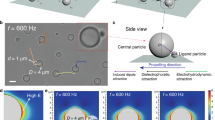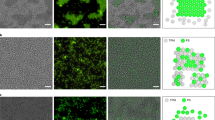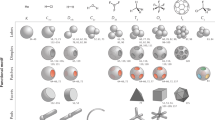Abstract
Interest in assemblies of colloidal particles1,2,3,4 has long been motivated by their applications in photonics5,6, electronics7,8, sensors8 and microlenses9. Existing assembly schemes10,11,12,13,14,15 can position colloids of one type relatively flexibly into a range of desired structures, but it remains challenging to produce multicomponent lattices, clusters with precisely controlled symmetries and three-dimensional assemblies16. A few schemes can efficiently produce complex colloidal structures2,17,18, but they require system-specific procedures. Here we show that magnetic field microgradients established in a paramagnetic fluid19,20 can serve as ‘virtual moulds’ to act as templates for the assembly of large numbers (∼108) of both non-magnetic and magnetic colloidal particles with micrometre precision and typical yields of 80 to 90 per cent. We illustrate the versatility of this approach by producing single-component and multicomponent colloidal arrays, complex three-dimensional structures and a variety of colloidal molecules from polymeric particles, silica particles and live bacteria and by showing that all of these structures can be made permanent. In addition, although our magnetic moulds currently resemble optical traps in that they are limited to the manipulation of micrometre-sized objects, they are massively parallel and can manipulate non-magnetic and magnetic objects simultaneously in two and three dimensions.
This is a preview of subscription content, access via your institution
Access options
Subscribe to this journal
Receive 51 print issues and online access
$199.00 per year
only $3.90 per issue
Buy this article
- Purchase on Springer Link
- Instant access to full article PDF
Prices may be subject to local taxes which are calculated during checkout





Similar content being viewed by others
References
Van Blaaderen, A., Ruel, R. & Wiltzius, P. Template-directed colloidal crystallization. Nature 385, 321–324 (1997)
Erb, R. M., Son, H. S., Samanta, B., Rotello, V. M. & Yellen, B. B. Magnetic assembly of colloidal superstructures with multipole symmetry. Nature 457, 999–1002 (2009)
Van Blaaderen, A. Colloidal molecules and beyond. Science 301, 470–471 (2003)
Manoharan, V. N., Elsesser, M. T. & Pine, D. J. Dense packing and symmetry in small clusters of microspheres. Science 301, 483–487 (2003)
Xia, Y., Gates, B. & Li, Z.-Y. Self-assembly approaches to three-dimensional photonic crystals. Adv. Mater. 13, 409–413 (2001)
Yethiraj, A., Thijssen, J. H. J., Wouterse, A. & van Blaaderen, A. Large-area electric-field-induced colloidal single crystals for photonic applications. Adv. Mater. 16, 596–600 (2004)
Hochbaum, A. I., Fan, R., He, R. & Yang, P. Controlled growth of Si nanowire arrays for device integration. Nano Lett. 5, 457–460 (2005)
Shipway, A., Katz, E. & Willner, I. Nanoparticle arrays on surfaces for electronic, optical, and sensor applications. ChemPhysChem 1, 18–52 (2000)
Lu, Y., Yin, Y. & Xia, Y. A self-assembly approach to the fabrication of patterned, two-dimensional arrays of microlenses of organic polymers. Adv. Mater. 13, 34–38 (2001)
Aizenberg, J., Braun, P. & Wiltzius, P. Patterned colloidal deposition controlled by electrostatic and capillary forces. Phys. Rev. Lett. 84, 2997–3000 (2000)
Hoogenboom, J. P. et al. Template-induced growth of close-packed and non-close-packed colloidal crystals during solvent evaporation. Nano Lett. 4, 205–208 (2004)
Yellen, B. B., Hovorka, O. & Friedman, G. Arranging matter by magnetic nanoparticle assemblers. Proc. Natl Acad. Sci. USA 102, 8860–8864 (2005)
Jiang, P., Prasad, T., McFarland, M. J. & Colvin, V. L. Two-dimensional non-close-packed colloidal crystals formed by spincoating. Appl. Phys. Lett. 89, 011908 (2006)
Miszta, K. et al. Hierarchical self-assembly of suspended branched colloidal nanocrystals into superlattice structures. Nature Mater. 10, 872–876 (2011)
Chen, Q., Bae, S. C. & Granick, S. Directed self-assembly of a colloidal kagome lattice. Nature 469, 381–384 (2011)
Ahn, B. Y. et al. Omnidirectional printing of flexible, stretchable, and spanning silver microelectrodes. Science 323, 1590–1593 (2009)
Dong, A., Ye, X., Chen, J. & Murray, C. B. Two-dimensional binary and ternary nanocrystal superlattices: the case of monolayers and bilayers. Nano Lett. 11, 1804–1809 (2011)
Wang, Y. et al. Colloids with valence and specific directional bonding. Nature 491, 51–55 (2012)
Rosensweig, R. E. Ferrohydrodynamics (Courier Dover Publications, 1997)
Shevkoplyas, S. S., Siegel, A. C., Westervelt, R. M., Prentiss, M. G. & Whitesides, G. M. The force acting on a superparamagnetic bead due to an applied magnetic field. Lab Chip 7, 1294–1302 (2007)
Bakker, C. J. G. & de Roos, R. Concerning the preparation and use of substances with a magnetic susceptibility equal to the magnetic susceptibility of air. Magn. Reson. Med. 56, 1107–1113 (2006)
Mirica, K. A., Shevkoplyas, S. S., Phillips, S. T., Gupta, M. & Whitesides, G. M. Measuring densities of solids and liquids using magnetic levitation: fundamentals. J. Am. Chem. Soc. 131, 10049–10058 (2009)
Perro, A. et al. A chemical synthetic route towards ‘colloidal molecules’. Angew. Chem. Int. Ed. 48, 361–365 (2009)
Coey, J. M. D., Aogaki, R., Byrne, F. & Stamenov, P. Magnetic stabilization and vorticity in submillimeter paramagnetic liquid tubes. Proc. Natl Acad. Sci. USA 106, 8811–8817 (2009)
Sun, Z., Guo, M., Vleugels, J., Blanpain, B. & Van der Biest, O. Induced migration of non-magnetic particles and fabrication of metallic-based graded materials by applying a strong magnetic field. J. Appl. Phys. 109, 084917 (2011)
Yang, J.-C. et al. Enhanced optical transmission mediated by localized plasmons in anisotropic, three-dimensional nanohole arrays. Nano Lett. 10, 3173–3178 (2010)
Bishop, K. J. M., Wilmer, C. E., Soh, S. & Grzybowski, B. A. Nanoscale forces and their uses in self-assembly. Small 5, 1600–1630 (2009)
Acknowledgements
We thank P. E. Fuller for his Matlab scripts. This work was supported by the Non-equilibrium Energy Research Center, which is an Energy Frontier Research Center funded by the US Department of Energy, Office of Science, Office of Basic Energy Sciences under award number DE-SC0000989.
Author information
Authors and Affiliations
Contributions
A.F.D. conducted colloid experiments and calculations. P.P.P. and B.K. performed experiments on the bacteria and nanoparticle assemblies. A.F.D., P.P.P. and B.K. prepared the figures. B.A.G. conceived the project, supervised the research, and wrote the paper.
Corresponding author
Ethics declarations
Competing interests
The authors declare no competing financial interests.
Supplementary information
Supplementary Information
This file contains Supplementary Methods, Supplementary Figures 1-16 and additional references. The Supplementary Methods and Figures provide details on the fabrication and characterization of the magnetic traps as well as the colloidal assemblies formed using the traps. (PDF 2374 kb)
A4 colloids
This video shows clusters of particles after they have been liberated from the template into a solvent (water). In this particular case the clusters shown are tetramers of particles. (MP4 384 kb)
A6 colloids
This video shows template-liberated triangular hexamers of particles after their release into water. (MP4 451 kb)
AB colloids
In this video, the liberated clusters released into water are heterodimers, AB, made from two different types of particles with different size and label. (MP4 931 kb)
AB2 colloids
The particular clusters of particles seen in this video, after liberation from their template and release into water, are made from two different types of particles to give AB2 structures (with A larger in size than the B-type particles). (MP4 414 kb)
Rights and permissions
About this article
Cite this article
Demirörs, A., Pillai, P., Kowalczyk, B. et al. Colloidal assembly directed by virtual magnetic moulds. Nature 503, 99–103 (2013). https://doi.org/10.1038/nature12591
Received:
Accepted:
Published:
Issue Date:
DOI: https://doi.org/10.1038/nature12591
This article is cited by
-
Regulation of species metabolism in synthetic community systems by environmental pH oscillations
Nature Communications (2023)
-
Bioinspired magnetic cilia: from materials to applications
Microsystems & Nanoengineering (2023)
-
Harmonic acoustics for dynamic and selective particle manipulation
Nature Materials (2022)
-
High-throughput production of functional prototissues capable of producing NO for vasodilation
Nature Communications (2022)
-
Programmed magnetic manipulation of vesicles into spatially coded prototissue architectures arrays
Nature Communications (2020)
Comments
By submitting a comment you agree to abide by our Terms and Community Guidelines. If you find something abusive or that does not comply with our terms or guidelines please flag it as inappropriate.



